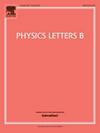Exploring nuclear structure with multiparticle azimuthal correlations at the LHC
IF 4.5
2区 物理与天体物理
Q1 ASTRONOMY & ASTROPHYSICS
引用次数: 0
Abstract
Details of the nuclear structure of Xe, such as the quadrupole deformation and the nuclear diffuseness, are studied by extensive measurements of anisotropic-flow-related observables in Xe–Xe collisions at a centre-of-mass energy per nucleon pair TeV with the ALICE detector at the LHC. The results are compared with those from Pb–Pb collisions at TeV for a baseline, given that the Pb nucleus exhibits a very weak deformation. Furthermore, comprehensive comparisons are performed with a state-of-the-art hybrid model using IP-Glasma+MUSIC+UrQMD. It is found that among various IP-Glasma+MUSIC+UrQMD calculations with different values of nuclear parameters, the one using a nuclear diffuseness parameter of and a nuclear quadrupole deformation parameter of provides a better description of the presented flow measurements. These studies represent the first systematic exploration of nuclear structure at TeV energies, utilizing a comprehensive set of anisotropic flow observables. The measurements serve as a critical experimental benchmark for rigorously testing the interplay between nuclear structure inputs and heavy-ion theoretical models.
在大型强子对撞机上用多粒子方位相关探索核结构
利用大型强子对撞机ALICE探测器对每核子对质心能sNN=5.44 TeV的Xe-Xe碰撞中与各向异性流相关的观测结果进行了大量测量,研究了129Xe的核结构细节,如四极子变形和核扩散。考虑到208Pb核表现出非常弱的变形,将结果与sNN=5.02 TeV时Pb-Pb碰撞的结果进行了比较。此外,采用IP-Glasma+MUSIC+UrQMD的最先进混合模型进行综合比较。研究发现,在不同核参数值的IP-Glasma+MUSIC+UrQMD计算中,核扩散参数a0=0.492,核四极变形参数β2=0.207能更好地描述所述的流动测量结果。这些研究代表了在TeV能量下对核结构的第一次系统探索,利用了一套全面的各向异性流动观测。这些测量为严格测试核结构输入和重离子理论模型之间的相互作用提供了关键的实验基准。
本文章由计算机程序翻译,如有差异,请以英文原文为准。
求助全文
约1分钟内获得全文
求助全文
来源期刊

Physics Letters B
物理-物理:综合
CiteScore
9.10
自引率
6.80%
发文量
647
审稿时长
3 months
期刊介绍:
Physics Letters B ensures the rapid publication of important new results in particle physics, nuclear physics and cosmology. Specialized editors are responsible for contributions in experimental nuclear physics, theoretical nuclear physics, experimental high-energy physics, theoretical high-energy physics, and astrophysics.
 求助内容:
求助内容: 应助结果提醒方式:
应助结果提醒方式:


